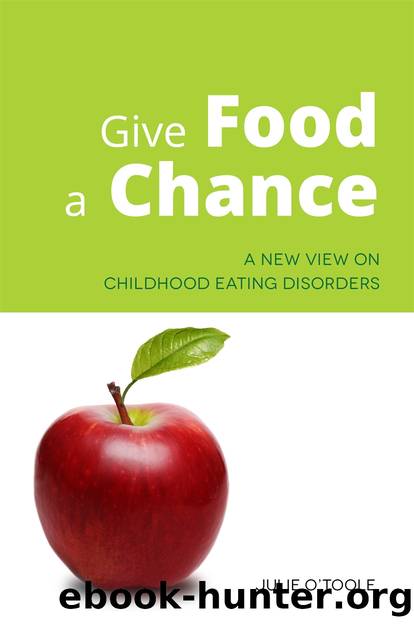Give Food a Chance by Julie O'Toole

Author:Julie O'Toole
Language: eng
Format: epub
ISBN: 9781784500993
Publisher: Jessica Kingsley Publishers
Published: 2015-02-27T00:00:00+00:00
13.2 The Kartini inpatient eating-disorder unit
A perfect eating-disorder inpatient unit would have dedicated beds, locked bathrooms, 24-hour psychiatric and medical nursing, and be physically contiguous with the DTU/PHP and other step-down programs as well as the outpatient clinic. There would be a large Ronald McDonald House nearby as well as cheap, safe housing for the parents of young adults; there would be a dedicated school, and more. Even the best childrenâs hospitals (including ours) do not meet all these ideals. Which ones are essential?
When I first began hospitalizing children with AN in our community childrenâs hospital, I experienced all the difficulties inherent in working with a generalist nursing staff who, although very competent, did not understand our type of patient. Additionally, the response to our patients from many other doctors on the ward ranged from puzzled to hostile. The treatment of the patients, when my back was turned, was punitive and often judgmental. The rules were harsh because we felt we could not explain treatment goals adequately to all shifts of all nurses. I felt myself too busy to take the time to train the nurses in the care of eating-disordered patients. Boy, was I wrong! It wasnât until I resigned myself to using my day off to do in-services for the nurses that things got better for us all. Immediately. Every hour I spent in those in-services paid off in years of cooperation, insight, and great nursing care on the part of the pediatric nurses. Once they understood the nature of the illness and the special requirements for their care, they became the childrenâs best allies and advocates. Although the eating-disorder service remains very structured, it became unnecessary to have punitive rules to make the patients cooperate. As soon as hospital staff understood the necessity for it, the hospital placed locks on all the bathroom doors to prevent purging or, much more commonly, surreptitious exercising.
A few years ago our childrenâs hospital instituted Nurse Case Managers for several services, including ours. At first we were not sure we wanted to be âmanaged,â but it turned out to be wonderful. Nurse managers do the day-to-day communication with the insurance companies and are on the floor to field questions and help families when the doctors are in their offices. Additionally they can help families arrange lodging at the Ronald McDonald House when appropriate.
All of our patients have their own room and bathroom (which is locked), most of them are on telemetry (continuous wireless cardiac monitoring), all meals are supervised by a nurse. Once patients are on Phase III (see Appendix C), they eat with the other eating-disordered patients in the common room, but always under supervision of a nurse.
A word about the Ronald McDonald Houses attached to many childrenâs hospitals: Never was a charity of more service to families with chronically ill children than the Ronald McDonald Houses! The fact that families can afford to stay near their ill child in cleanliness, comfort, and psychological support is near miraculous. I would urge all people concerned with the care of children to support their local Ronald McDonald House.
Download
This site does not store any files on its server. We only index and link to content provided by other sites. Please contact the content providers to delete copyright contents if any and email us, we'll remove relevant links or contents immediately.
The Art of Thinking Clearly by Rolf Dobelli(10234)
The 5 Love Languages: The Secret to Love That Lasts by Gary Chapman(9609)
Mindhunter: Inside the FBI's Elite Serial Crime Unit by John E. Douglas & Mark Olshaker(9214)
Becoming Supernatural by Dr. Joe Dispenza(8127)
Nudge - Improving Decisions about Health, Wealth, and Happiness by Thaler Sunstein(7622)
The Road Less Traveled by M. Scott Peck(7525)
Enlightenment Now: The Case for Reason, Science, Humanism, and Progress by Steven Pinker(7244)
Mastermind: How to Think Like Sherlock Holmes by Maria Konnikova(7234)
Win Bigly by Scott Adams(7097)
The Way of Zen by Alan W. Watts(6513)
Factfulness: Ten Reasons We're Wrong About the World – and Why Things Are Better Than You Think by Hans Rosling(4696)
The State of Affairs by Esther Perel(4645)
Gerald's Game by Stephen King(4584)
Man's Search for Meaning by Viktor Frankl(4439)
The Confidence Code by Katty Kay(4193)
Thinking in Bets by Annie Duke(4154)
The Healing Self by Deepak Chopra(3478)
Hidden Persuasion: 33 psychological influence techniques in advertising by Marc Andrews & Matthijs van Leeuwen & Rick van Baaren(3476)
The Worm at the Core by Sheldon Solomon(3438)
